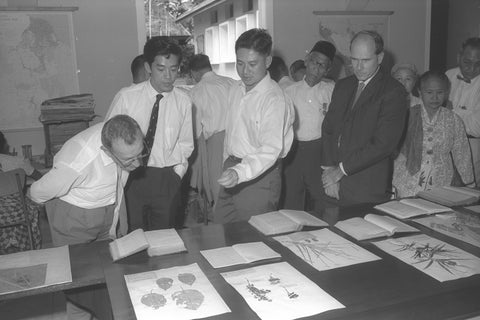News
Follow NUS Press on
Launch of "Nature's Colony" at the Singapore Botanic Gardens October 21, 2016 11:00
Timothy Barnard launched his latest book, Nature’s Colony: Empire, Nation and Environment in the Singapore Botanic Gardens, at the Singapore Botanic Gardens on October 14, as part of the Gardens' regular speaker series.


(Photos courtesy of Sebastian Song)
Professor Barnard centred his talk around the history of the Gardens and its broader impact beyond its bounadries in environmental, political, and
social terms.


(Photos courtesy of Sebastian Song)
Professor Barnard explained that the botanic gardens was established as a private park between 1869 and 1874. By the early 1870s, the British realised that it had the potential of becoming a key colonial institution because imperial botany was seen as a tool that could strengthen empire (i.e. rubber seeds could be harvested in Singapore and Malaya, which could then be traded as a commodity).
The ever-changing position of the Singapore Botanic Gardens in society and politics over time has also often been overlooked: Professor Barnard emphasised the Gardens' precarious position as a colonial institution in a decolonialising society in a post-Merdeka era.

Humphrey Burkill, Director of the Singapore Botanic Gardens from 1957 to 1969, leading a tour of government officials at the opening of the “renovated” herbarium in October 1964 (Source: Ministry of Information and Arts Collection, courtesy of the National Archives of Singapore).
One of the highights of the talk was a segment on Henry Ridley, the Director of the Singapore Botanic Gardens between 1888 and 1912. Ridley was seen as “mad” by many of his contemporaries within the colonial government in Singapore due to his quirks and views of how the Singapore Botanic Gardens should be developed.
Ridley accomplished a lot during his tenure as director—from overseeing the set up of a short-lived zoo (1875-1905), to the establishing an Economic Garden within the park. Ridley also had the foresight to see that planting oil palm would have economic advantages for the region.

Henry Ridley with a small panther (Image reproduced with the kind permission of the Board of Trustees of the Royal Botanic Gardens, Kew).
The talk was followed by a lively question and answer session that was moderated by the Group Director of the Singapore Botanic Gardens, Dr Nigel Taylor.

(Photo courtesy of Sebastian Song)
At the end of the talk, many queued up patiently for Barnard to sign their copies of Nature’s Colony.



(Photos courtesy of Sebastian Song)
We would like to thank the Singapore Botanic Gardens for hosting the launch. If you would like to hear snippets of what Barnard said that day, you can check out his interview with talkshow host, Michelle Martin, on 93.8 Live’s Culture Café here, where he discussed his book and the history of the Gardens.
Launch of "Photography in Southeast Asia" in Singapore October 18, 2016 17:00
Zhuang Wubin's Photography in Southeast Asia: A Survey was launched at Objectifs Centre for Photography and Film on October 13, 2016. The launch featured a dialogue between Zhuang and famed street photographer, Chia Aik Beng, followed by a lively question and answer session.

(Photo courtesy of Kevin Lee)
Zhuang and Chia discussed the influence and impact social media has had on photography. When asked by Zhuang about the advantages and disadvantages of using Instagram as a platform for showcasing work, Chia said, "Instagram is a social media platform; it is not a photo gallery or website. If I'm on a project, I will share some images [on my Instagram account], to tease people and then direct them to my website. This is how I distribute information."





For a detailed transcript of what was discussed during the book launch, you can read Invisible Photographer Asia's coverage of it here. We are grateful to Objectifs for sponsoring the venue for this book launch, and to Kevin Lee for being the official photographer of the event.
